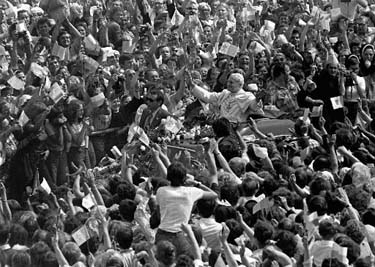
I have covered far happier times for the Vatican. I reported on John Paul II’s pilgrimage through his native Poland some three decades ago, and I have been thinking about this while watching the Catholic Church’s 115 cardinal electors pray for divine inspiration on this historic day in Rome’s Sistine Chapel.
The cardinals will need every ounce of God’s help to determine who among them has the leadership and managerial wherewithal to both fix their scandal-ridden church and inspire a needy world. They can take some solace from the 1978 papal conclave held after John Paul I’s sudden death following just 33 days in office.
Electors then took eight ballots and two days to select Cardinal Karol Wojtyla, then the archbishop of Krakow, as the first non-Italian pope since 1523 and a man who over time would become one of the great leaders of the 20th century. John Paul II was beatified in 2011, in no small part for the role he played in liberating his homeland and ending Communist rule over most of Eastern Europe.
No elector then could have known the chain of events he had set in motion. Consider, I filed the dispatch below to my editors at the Wall Street Journal from Czestochowa, Poland, where the pope had come to celebrate the 600th anniversary of the icon of the Black Madonna. The Black Madonna had been acclaimed for everything from stopping Swedish invaders to healing the disabled, and John Paul II credited her with saving his life after he took an assassin’s bullet two years earlier. I wrote:
It was Polish Woodstock staged around religion instead of rock music.Masses of young people with backpacks and blankets started gathering two days before their Polish pope would arrive. By the time he climbed the grand altar atop the Jasna Gora Monastery’s majestic hill top, they easily numbered a million and stretched for nearly a mile at his feet … The crowd greeting him here was packed so tight that even crossing oneself at mention of the Trinity proved awkward.
Surveying the spectacle closely, I watched John Paul II’s face radiate the profound warmth and joy that, during his seven-day journey to Poland, would restore the spirit of a nation broken by martial law. Communist leaders had imposed these harsh restrictions two and a half years earlier, seeking to snuff out the Solidarity movement, a nationwide democratic revolution that threatened the Soviet empire.
The Polish pope, amplified so all could hear, spoke to his faithful in a voice that moved them to action – but also counseled against violence. “My dear young friends,” he said. “[Mary] knows your sufferings, your difficult youth, your sense of injustice and humiliation, the lack of prospects for the future that is often felt, perhaps the temptations to flee to some other world.”
The crowd repeatedly broke up his sentences with applause, thanking their pope for voicing their tribulations. “On you depends tomorrow …,” John Paul II said. “I pray for you every day.”
This story is a reminder of how messy had been the choice of this man, the second-longest-serving pope in history, who served until his death in 2005. Yet when that 1978 conclave began, electors were divided between Giuseppe Siri, the conservative archbishop of Genoa, and Giovannni Benelli, the liberal archbishop of Florence. Wojtyla was the late-entry, compromise candidate. He was put forward by Franz König, the Austrian cardinal, only when it became apparent that neither candidate could attain the two-thirds majority required and that a third Italian candidate refused to serve.
Yet the 20th century might have turned out differently had the electors that day not chosen a man who, at age 58, was athletically energetic, uniquely charismatic and historically relevant as a son of a captive Poland. Pope John Paul II’s 1979 and 1983 trips to his homeland first inspired a national awakening and then revived it – laying the groundwork for the Berlin Wall’s fall, Soviet collapse and the Cold War’s peaceful end.
There is, however, a cautionary lesson to the John Paul II story. By remaining pope beyond the point of his physical and mental capabilities, his legacy is mixed. Almost all the financial and sex scandals that have bedeviled the Catholic Church metastasized because of the Polish pope’s inattention during his final years.
It was that reality that likely drove the decision of Pope Benedict XVI to resign his papacy at age 85 on Feb. 28, citing a “lack of strength of mind and body.” He was the first pope to step down since Pope Gregory XII in 1415, and the first to do so voluntarily since Pope Celestine V in 1294.
No one knew the two stages of Pope John Paul II’s papacy better. Benedict XVI witnessed both the remarkable man who had shaped history and the declining individual who presided haplessly over the Catholic Church’s growing difficulties. Instead of perhaps suffering a similar fate, Benedict XVI decided to determine his own destiny – and provide the electors today their historic opportunity.
Whoever the cardinals choose will face a more complex challenge than John Paul II confronted during the Cold War’s final decade. No one man in the conclave today could likely possess both the personality and oratory gifts to wow the world and the managerial talents and temperament to galvanize and reform a globalized church of 1.2 billion followers at a time of paralyzing scandals.
Perhaps the most important lesson of the Polish pope is that history won’t be made in the Sistine Chapel today – but in the years that follow.
Frederick Kempe is president and CEO of the Atlantic Council. This column was originally published by Reuters.
Photo credit: Wikipedia
Image: Pope-poland.jpg
